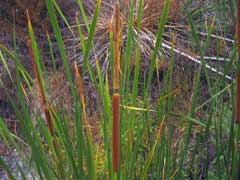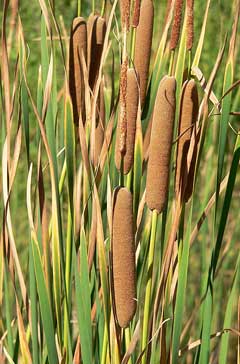 |
|
|
 |
| commons.wikimedia.org/wiki/User:Stan_Shebs |
Translate this page:
Summary
Physical Characteristics

 Typha domingensis is a PERENNIAL growing to 3 m (9ft 10in).
Typha domingensis is a PERENNIAL growing to 3 m (9ft 10in).
See above for USDA hardiness. It is hardy to UK zone 5. The species is monoecious (individual flowers are either male or female, but both sexes can be found on the same plant) and is pollinated by Wind.
Suitable for: light (sandy), medium (loamy) and heavy (clay) soils. Suitable pH: mildly acid, neutral and basic (mildly alkaline) soils and can grow in saline soils.
It cannot grow in the shade. It prefers wet soil and can grow in water.
UK Hardiness Map
US Hardiness Map
Synonyms
T. angustata. Bory-Chaubard.
Plant Habitats
Pond; Bog Garden;
Edible Uses
Edible Parts: Flowers Leaves Oil Pollen Root Seed Shoots Stem
Edible Uses: Oil
Rhizomes - raw or cooked[145
]. A sweet flavour[105
, 277
]. Rich in starch, around 30 - 46%, they can be boiled and eaten like potatoes or macerated and then boiled to yield a sweet syrup[172
]. The rhizome can also be dried, ground into a powder and then used as a thickener in soups etc or added to cereal flours. Rich in protein, this flour is used to make biscuits, bread, cakes etc[183
].
The rhizomes at the base of erect shoots are mostly horizontal, unbranched, up to 70 cm long and 5 - 40mm in diameter. They are starchy, firm and scaly[270
].
The root contains a lot of fibre[193
]. One way to remove this fibre is to peel lengths of the root that are about 20 - 25cm long, place them by a fire for a short while to dry and then twist and loosen the fibres when the starch of the root can be shaken out[193
].
Young shoots in spring - raw or cooked[193
]. An asparagus substitute. The inner core is eaten[172
]. The young shoots are cut from the underground stems in the spring when they are about 10 - 40cm long[277
].
The base of the mature stem - raw or cooked. It is best to remove the outer part of the stem. The base of the stem where it attaches to the rhizome can be boiled or roasted like potatoes[277
].
Young flowering stem - raw, cooked or made into a soup. Tastes like sweet corn[172
].
Seed - cooked. The seed is rather small and fiddly to utilize, but has a pleasant nutty taste when roasted.
Edible oil is obtained from the seed[85
]. The seeds contain about 18 - 20% oil, of which 69% is linolenic acid[270
]. Due to the small size of the seed, this is probably not a very worthwhile crop.
Pollen - raw or cooked. A protein-rich additive to flour used in making bread, porridge etc[105
, 183
]. It can also be eaten with the young flowers, which makes it considerably easier to utilize. The pollen is a bright yellow or green colour, and turns pancakes, cookies or biscuits a pretty yellow colour[277
].
The pollen can be harvested by placing the flowering stem over a wide but shallow container and then gently tapping the stem and brushing the pollen off with a fine brush[9
]. This will help to pollinate the plant and thereby ensure that both pollen and seeds can be harvested[K
].
References More on Edible Uses
Medicinal Uses
Plants For A Future can not take any responsibility for any adverse effects from the use of plants. Always seek advice from a professional before using a plant medicinally.
Astringent Diuretic Haemostatic Miscellany Vulnerary
The leaves are diuretic[218]. The pollen is astringent, desiccant, diuretic, haemostatic and vulnerary[176, 218]. It is used in the treatment of nose bleeds, haematemesis, haematuria, uterine bleeding, dysmenorrhoea, postpartum abdominal pain and gastralgia, scrofula and abscesses[176]. It is contraindicated for pregnant women[176]. The seed down is haemostatic[218]. The rootstock is astringent and diuretic[240].
References More on Medicinal Uses
The Bookshop: Edible Plant Books
Our Latest books on Perennial Plants For Food Forests and Permaculture Gardens in paperback or digital formats.

Edible Tropical Plants
Food Forest Plants for Hotter Conditions: 250+ Plants For Tropical Food Forests & Permaculture Gardens.
More

Edible Temperate Plants
Plants for Your Food Forest: 500 Plants for Temperate Food Forests & Permaculture Gardens.
More

More Books
PFAF have eight books available in paperback and digital formats. Browse the shop for more information.
Shop Now
Other Uses
Biomass Compost Fibre Filter Fuel Insulation Miscellany Oil Paper Roofing Soil stabilization String Stuffing Thatching Tinder Waterproofing Weaving
Agroforestry Uses:
The plant's extensive root system makes it very good for stabilizing wet banks of rivers, lakes etc[200
, 418
].
It can be grown in reed beds and other water purification systems in order to remove various kinds of pollutants from the water and soil. The top growth is removed once or twice during the growing season - it can either be used as a fuel or the materials recovered from it[270
].
Other Uses:
The stems and leaves have many uses, they make a good thatch, being used on roofs, to make walls and floor coverings[13
, 46
, 57
, 61
, 94
, 145
, 257
, 270
].
They can be used in weaving to make items such as mats, chairs, hats and other handicrafts[13
, 46
, 57
, 61
, 94
, 270
].
They can be used as a caulking material for barrels, boats etc[270
].
A fibre obtained from the leaves and stems can be used in making paper[13
, 46
, 57
, 61
, 94
].
A fibre obtained from the roots can be used for making string[193
].
The plant produces large amounts of biomass, comparable to the most productive agricultural crops. This is a potential source of energy - it can, for example, be used for alcohol manufacture[270
]. On a domestic level, the stems make an excellent addition to the compost heap or can be dried and used as a source of fuel etc.
The hairs of the fruits are used as a stuffing material for pillows, mattresses, toys etc[46
, 57
, 159
]. They have good buoyancy properties and have been used in life preservers. They also have excellent insulation properties and have been used in construction[171
, 270
].
The female flowers make an excellent tinder and can be lit from the spark of a flint[212
].
The pollen is highly inflammable and is used in making fireworks[115
].
Special Uses
Food Forest
References More on Other Uses
Cultivation details
A plant of the warm temperate zone through to the tropics, where it is found at elevations up to 1,500 metres. It grows best in areas where annual daytime temperatures are within the range 16 - 28°c, but can tolerate 14 - 30°c[418
]. When dormant, the plant can survive temperatures down to about -25°c, but young growth can be severely damaged at 0°c[418
]. It prefers a mean annual rainfall in the range 400 - 1,400mm, but tolerates 250 - 1,600mm[418
].
Succeeds in sun or part shade[200
]. Grows in boggy pond margins or shallow water to 15cm deep[1
, 200
]. Requires a rich wet soil if it is to well[200
]. Tolerates moderate levels of salt[418
]. Prefers a pH in the range 6.5 - 7.5, tolerating 6 - 8[418
].
Plants can be very invasive, spreading freely at the roots when in a suitable site[200
]. Typha domingensis aggressively invades and forms nearly pure stands in brackish or nutrient-enriched wetlands in the Florida Everglades and elsewhere. It is established but does not mature fruits on the cold coast of northern California[270
].
References Carbon Farming Information and Carbon Sequestration Information
Temperature Converter
Type a value in the Celsius field to convert the value to Fahrenheit:
Fahrenheit:
The PFAF Bookshop
Plants For A Future have a number of books available in paperback and digital form. Book titles include Edible Plants, Edible Perennials, Edible Trees,Edible Shrubs, Woodland Gardening, and Temperate Food Forest Plants. Our new book is Food Forest Plants For Hotter Conditions (Tropical and Sub-Tropical).
Shop Now
Plant Propagation
Seed - surface sow in a pot and stand it in 3cm of water. Pot up the young seedlings as soon as possible and, as the plants develop, increase the depth of water. Plant out in summer. Division in spring. Very easy, harvest the young shoots when they are about 10 - 30cm tall, making sure there is at least some root attached, and plant them out into their permanent positions.
Other Names
If available other names are mentioned here
Kaylampa, Lesser cats tail, Malo, Maranda, Poorteetch, Reedmace, Tabua, Wonga, , al-sa’ait, al-sa’d, bardi, cattail, cattail (typha domingensis), cumbungi, enugajamu, ghaabaajariyu, gondpater, gundra, gundra? (rhizome and fruit), gun?ha?, gu??ha?, hogalap, jammugaddi, lesser indian reed-mace, lesser reed-mace, narrow-leaf cumbungi, paankanis, pater, piripepe, pirivevýi, ramban, semercik koza, southern cattail, totora.
Native Range
EUROPE: Russian Federation (Kalmykija, Respublika, Astrakhan, Volgogradskaja oblast)
Weed Potential
Right plant wrong place. We are currently updating this section.
Please note that a plant may be invasive in one area but may not in your area so it's worth checking.
Conservation Status
IUCN Red List of Threatened Plants Status : Status: Least Concern

Growth: S = slow M = medium F = fast. Soil: L = light (sandy) M = medium H = heavy (clay). pH: A = acid N = neutral B = basic (alkaline). Shade: F = full shade S = semi-shade N = no shade. Moisture: D = dry M = Moist We = wet Wa = water.
Now available:
Food Forest Plants for Mediterranean Conditions
350+ Perennial Plants For Mediterranean and Drier Food Forests and Permaculture Gardens.
[Paperback and eBook]
This is the third in Plants For A Future's series of plant guides for food forests tailored to
specific climate zones. Following volumes on temperate and tropical ecosystems, this book focuses
on species suited to Mediterranean conditions—regions with hot, dry summers and cool, wet winters,
often facing the added challenge of climate change.
Read More
Expert comment
Author
(Pers.)Steud.
Botanical References
50200
Links / References
For a list of references used on this page please go here
A special thanks to Ken Fern for some of the information used on this page.
Readers comment
© 2010, Plants For A Future. Plants For A Future is a charitable company limited by guarantee, registered in England and Wales. Charity No. 1057719, Company No. 3204567.